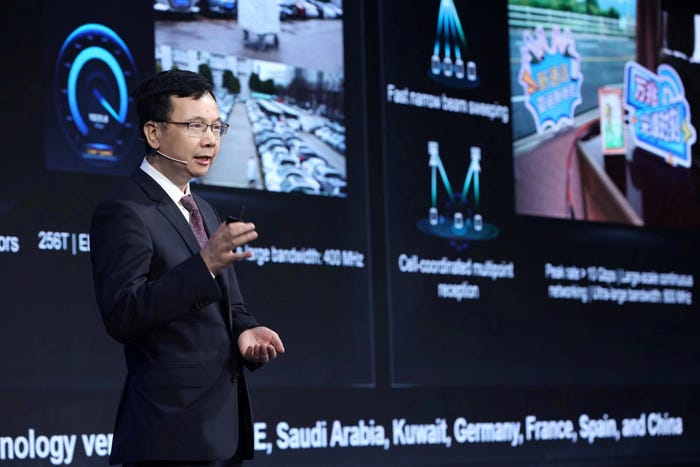5G set to take big step forward with 5G-Advanced5G set to take big step forward with 5G-Advanced
July 13, 2023

Sponsored Content
Next year marks a huge step forward in the evolution of 5G – the arrival of 5G-Advanced.
The upgraded 5G standard will bring more powerful features that are expected to enable new use cases and experiences, foster new business segments and drive demand and operator revenue growth.
Some of the new technical capabilities will include AI-driven system design, better optimization for XR services, and all-scenario diversified IoT that improves the scale and quality of connected things.
Yang Chaobin, Director of Huawei and President of ICT Products and Solutions, announced at the 2023 MWC Shanghai event in June that Huawei will launch a complete set of commercial 5.5G network solutions in 2024.

He said that with 260 5G commercial networks worldwide and a customer base of more than 1.2 billion, there is a ready market to enjoy new and innovative services enabled by the evolution of the standard.
Mr Yang stressed that 5G-Advanced is the essential evolutionary path from 5G to 6G, ensuring both enhanced network performance and the protection of operators’ 5G investments.
Huawei has been working closely with operators and technology partners to develop and test key 5.5G technical capabilities.
The vendor’s 5.5G solutions include extremely large antenna array (ELAA) technology with a 10Gbps downlink, flexible spectrum access technology that can provide gigabit uplinks, and Passive-IoT that can enable 100 billion IoT connections.
Mr Yang said Huawei’s end-to-end 5.5G solutions would come in three parts – 5.5G for mobile networks, F5.5G for fixed networks, and Net5.5G for core networks.
For F5.5G, 50G PON will be the key to enabling 10G ultra-broadband experience. It will be widely used in homes, campuses, and business. Huawei has completed technology and application trials with 30 operators around the world.
Net5.5G will provide the key capabilities of 10G access, ultra-wide transmission and microsecond AI latency, creating the foundation for a new generation of digital enterprise services.
Huawei believes that one of the critical requirements of 5G-Advanced will be to enable the cloud to seamlessly integrate with the core network to ensure end-user devices can take full advantage of cloud AI.
“Since we want to combine the cloud with the terminal equipment, access alone is not enough,” Mr Yang said. “The entire network, including the network of the data center, must be able to connect end-to-end. Only in this way can industries fully enjoy AI in the cloud.
“We know that the 5G core network is CloudNative. The coming 5.5G era will be AINative,” he said.
He said the 5.5G core network would have three roles in AI: supporting intelligent O&M for the network; enabling generative AI that will provide richer consumer services; and delivering network intelligence to meet the requirements of different industries.
In the IoT segment, Mr Yang said any object can be intelligent if it is connected to the internet. The previous definition did not define the technology for IoT.
“If we want to connect everything intelligently in the future, we must introduce new IoT technologies, such as RedCap and Passive-IoT (P-IoT). We believe that the introduction of these technologies can greatly reduce the cost of terminals and greatly improve the standby time of terminal batteries.”
He said IoT in 5G-Advanced would be a balance between performance, cost and terminal standby. Because it does not require batteries at all, P-IoT will drive the widespread use of mobile IoT technology around the world, Mr Yang said.
After conducting a series of tests with global customers over the past three years, Huawei believes the goal of 100 billion IoT devices is technically achievable.
The enhanced 5G standard is endorsed by operators and vendors across the telecom sector and backed by the leading operator organization, the GSMA.
To offer a glimpse into the transformative potential of 5G-Advanced, the GSMA has collaborated with the industry to list some of the new use cases expected to emerge.
The GSMA and its partners identified use cases including enhanced AR, VR and XR immersive services, and connectivity in high-speed scenarios such as bullet trains and inflight.
They said 5G-Advanced will also improve the precision and integrity of location services, open up timing-as-a-service as an important segment, and support uncrewed aerial vehicles and seamless interworking between terrestrial and satellite networks.
Over time, 5G-Advanced could evolve to support integrated sensing and communication, ambient IoT and robotics and tactile communication services, the GSMA group said.
About the Author
You May Also Like










.png?width=300&auto=webp&quality=80&disable=upscale)


_1.jpg?width=300&auto=webp&quality=80&disable=upscale)